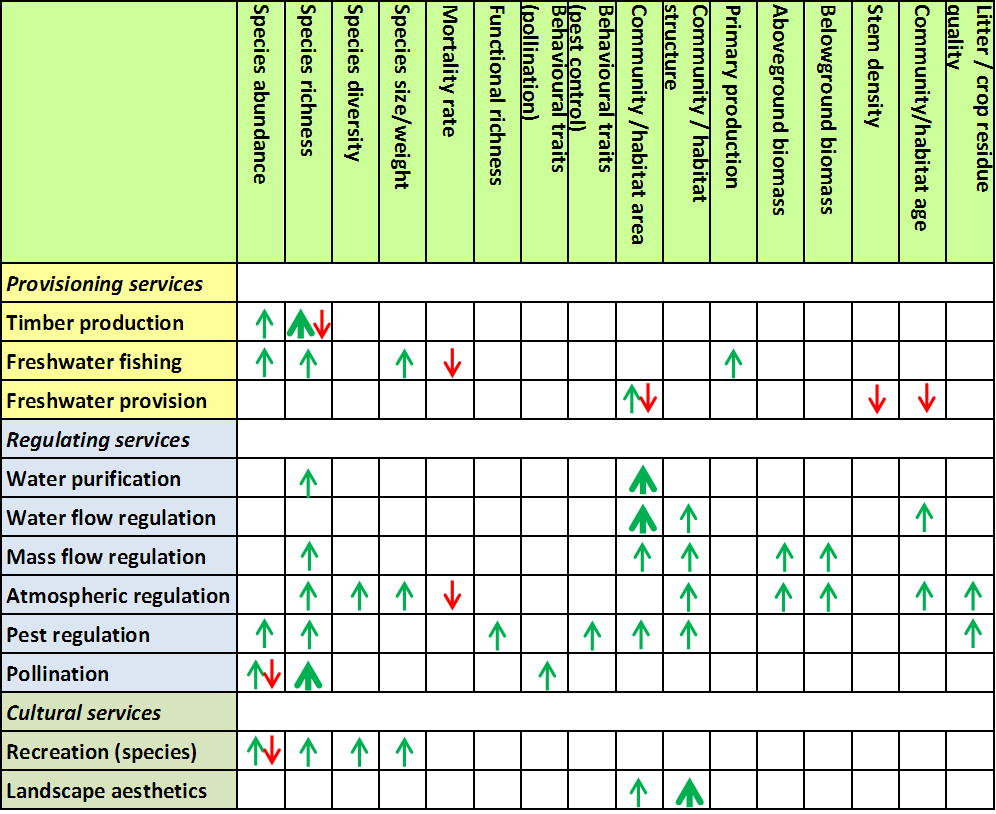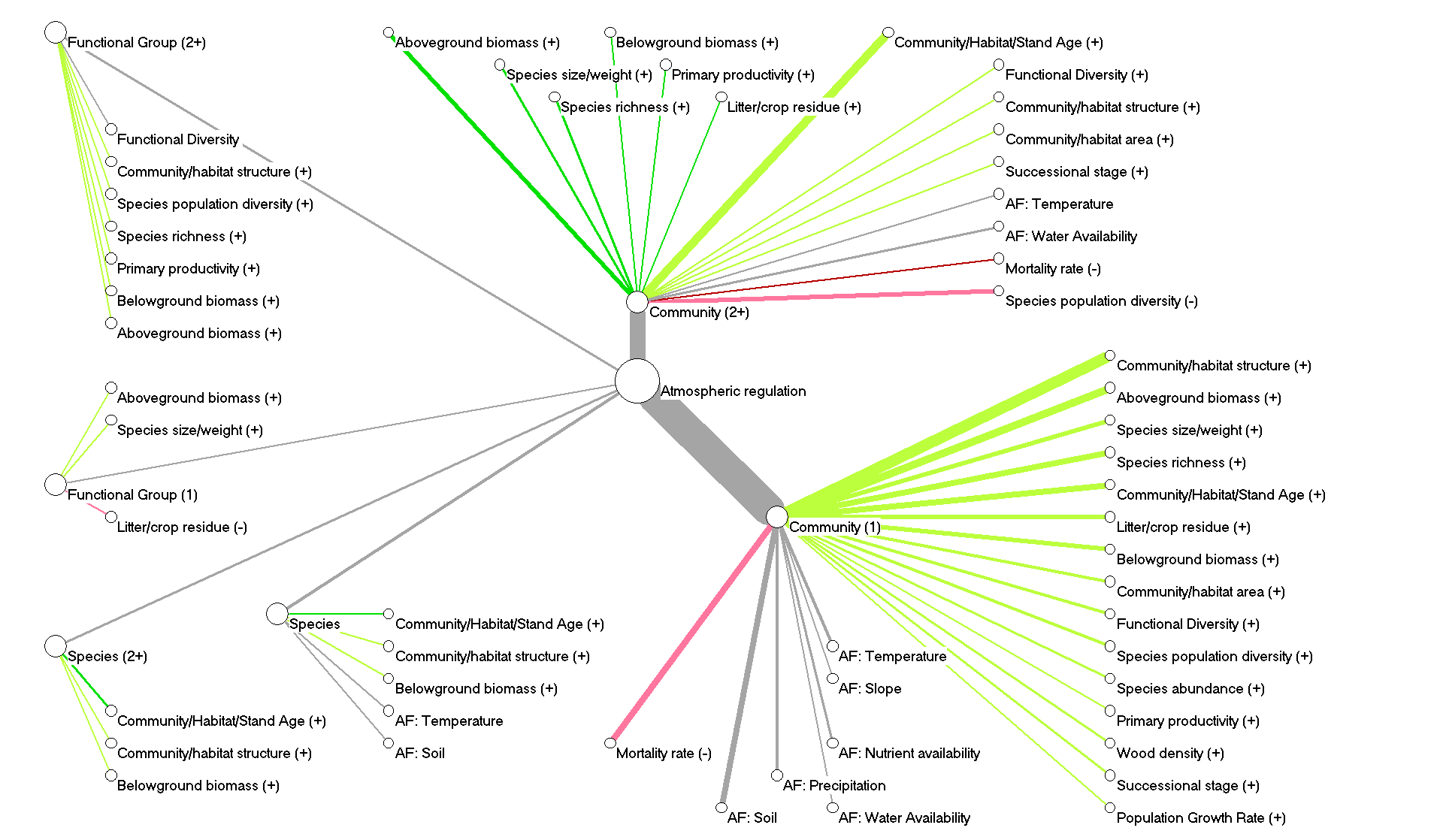![]()
Topic
We know that nature provides ecosystem services of value to humans, but we often don’t know exactly how this happens. People often refer to “biodiversity” in a very general way, and it is not clear exactly what aspects of biodiversity are important for delivering the services that we need. For example, are older or younger forests better for storing carbon? Do particular wetland species perform better than others for water purification? Does the number of species present (species richness) make a difference?
We examined different aspects of biodiversity – including individual species, entire habitats such as forests, particular traits such as size, and the variety of life itself, as indicated by the number of species in an area (species richness) or the number of groups of species with similar characteristics (functional richness). We gathered evidence for the way in which these different biodiversity attributes contribute to eleven selected ecosystem services, based on a literature review of around 50 papers for each service. The papers came from across the world, though for some services the literature was dominated by papers from Europe and North America. They also included studies at a range of spatial scales: the majority were local-scale experimental studies, but there were also studies at a regional or national scale, and some global reviews or meta-analyses.
The eleven ecosystem services include three provisioning services (timber production, freshwater fishing and freshwater provision), six regulating services (water purification, water flow regulation (flood protection), mass flow regulation (erosion protection), atmospheric regulation (carbon storage), pest regulation and pollination), and two cultural services (species-based recreation, such as hunting or eco-tourism, and aesthetic landscapes).
The results are summarised in Figure 1. This shows the predominant direction of the links (positive or negative) to various biodiversity attributes for each ecosystem service. The review found that the links are mainly positive, shown by the dominance of green up-arrows on Figure 1. The most commonly cited biodiversity attributes across all the services reviewed are:


- The community or habitat area, age and biomass. For example, greater areas of forest in a catchment provide more flood protection; wetlands improve water quality; permanent vegetation prevents erosion on steep slopes. Longer-established habitats can provide a greater service, especially for flood protection and carbon storage, where the service is directly related to the amount of biomass (both above and below ground).
- The abundance and characteristics of particular species. This is important for provisioning services (fishing and timber), species-based recreation (e.g. eco-tourism, hunting), pest regulation and pollination. Species size is important for some services, e.g. larger trees store more carbon; large fish species are more important for fishing. For pest regulation and pollination, the behaviour of the species is also important.
- Species richness and functional richness. These are important for many services, especially carbon storage, timber production, freshwater fishing, pest regulation and pollination. This is due to two mechanisms: (i) niche complementarity, e.g. a mix of plant species with different heights and root depths can more fully exploit available sunlight, water and nutrients, and (ii) the selection effect, where there is a greater chance of high-performing species occurring in a richer community. Species richness and diversity (a combination of richness and abundance) were also found to be good for recreation (eco-tourism).
- Community/habitat structure. More complex structures (e.g. old-growth forests, or wetlands with varied vegetation heights) often provide a greater level of service. Structural diversity is also important for providing good habitat for pest predators and pollinators, and improves the aesthetic value of landscapes.
Some examples of negative links were found, shown by red down-arrows on Figure 1. Not surprisingly, the attribute of “mortality rate” (i.e. death of plants or animals) had purely negative links with ecosystem service delivery, though this is often due to human activity and could therefore be viewed as an external impact rather than a biodiversity attribute. Negative impacts were also found to arise from the introduction of non-native species, such as the choking of waterways by invasive plants. In pollination systems, managed bees may compete with wild bee species for pollen and nectar. Finally, forest plantations were often found to reduce the supply of fresh water.
The way in which biodiversity attributes contribute to ecosystem services can also be shown as network diagrams. Figure 2 shows an example, for the service of atmospheric regulation (carbon storage). The diagram shows how the service originates from various “ecosystem service providers”, which can be populations of one or more species, one or more functional groups (i.e. groups of species with similar functional ecological roles, such as, in this instance, coniferous trees) or one or more entire habitats or communities. For atmospheric regulation, the main ecosystem service provider is the entire community or habitat, such as a forest, or two or more communities or habitats, e.g. for studies that compared different types of forest. The diagram reveals the complexity of the relationships between biodiversity and service provision, but some key trends emerge. The important biodiversity attributes include the age and structure of the community, with older and more complex forests typically storing more carbon, as well as above and below-ground biomass, species size, productivity, species richness and habitat area. Mortality rate has a negative influence (e.g. through loss of trees to pests, diseases or forest fires).
We cannot tell at this stage whether the thin lines in the diagram represent weak relationships or simply a lack of evidence, as some ecosystem services and biodiversity attributes have been studied more than others. Further work is needed to fully understand the complex web of interdependence between biodiversity attributes and ecosystem services.


Usefulness
This is the first comprehensive review of evidence on the mechanisms by which different aspects of biodiversity contribute to ecosystem services. The literature explicitly addressing the links between biodiversity and ecosystem services is limited, and the number of papers mentioning a link does not necessarily indicate the functional importance of that link, but the review gathers together a useful bibliography of papers that demonstrate the importance of biodiversity in providing services of value to humans. This is a vital evidence base for those arguing for the need for greater levels of protection for biodiversity. It also indicates which aspects of biodiversity are likely to be important for providing particular services. This information could be used to devise effective land management strategies that maximise delivery of particular services or bundles of related services. The results also identify areas where there are negative impacts on ecosystem services. Again, this can be used to inform management decisions and to balance trade-offs between services. Finally, the work identifies knowledge gaps and areas for future research.
Transferability
Many of the general conclusions on the importance of different biodiversity attributes for different ecosystem services are broadly applicable and transferable to other contexts. For example, provision of natural habitat adjacent to crops is likely to be beneficial for pollination and pest regulation in any location, and forests are always likely to provide flood protection and carbon storage.
However, the direction of impact can be specific to the context. One example of this is for the influence of forests on freshwater provision: forests were generally found to reduce freshwater supply through rainfall interception, evaporation and transpiration, but there were some cases where forests played an important positive role in providing freshwater, particularly for cloud forests (which trap moisture from fog) or old-growth forests (where groundwater infiltration is enhanced). For both freshwater provision and flood protection, the impact of a forest would depend strongly on local hydrology, soil type and climate, and on whether water supply and/or flooding are significant problems in the area. Another example is for the service of aesthetic landscapes, where most cultural groups appreciated more natural landscapes but some preferred landscapes with more human management.
Lessons learned
- There are strong synergies between biodiversity conservation and many regulating and cultural ecosystem services. Rich and diverse ecosystems can simultaneously deliver multiple services such as carbon storage, flood protection, water purification, soil stability, recreation opportunities and aesthetic landscapes, as well as providing habitat for wildlife. Evidence on these synergies, compiled from this literature review, can strengthen the case for protecting biodiversity.
- There are also conflicts between ecosystem services. For example, provisioning services such as farming, fishing and timber extraction may damage wildlife habitat and reduce the ability of ecosystems to provide regulating or cultural services.
- Careful management is essential to exploit synergies and minimise conflicts, such as by protecting and restoring ecosystems, promoting eco-tourism and sustainable agriculture, preventing over-extraction of resources, and reducing water pollution.
- Links between biodiversity and ecosystem services are complex. Even though these links are not yet fully understood, present knowledge may already be used to design better strategies for land management to enhance biodiversity and ecosystem protection.
Looking for more information on effective arguments for biodiversity?
The results of the literature review are also reported in an academic paper: Harrison et al. (2014), ‘Linkages between biodiversity attributes and ecosystem services: A systematic review’. Ecosystem Services 9, pp. 191-203. Available from http://www.sciencedirect.com/science/article/pii/S2212041614000576
Full results and analysis are contained in Part 1 of the BESAFE Work Package 4 deliverable: http://www.besafe.pensoft.net/files/DOWNLOAD2/BESAFE_D4.1_Synthesis_Final.pdf.
For more BESAFE results, including separate briefs focusing on other case studies and various aspects of argumentation, see http://www.besafe.pensoft.net
The OpenNESS project (Operationalisation of Natural Capital and Ecosystem Services) has extended this literature review. See Deliverable 3.1 at http://www.openness-project.eu/library.
This brief is a result of research carried out under the BESAFE project. This brief was written by Alison Smith, Dr Paula Harrison and Dr Pam Berry. For further details on the BESAFE review, contact Alison Smith (alison.smith@ouce.ox.ac.uk) or Dr Paula Harrison (paula.harrison@ouce.ox.ac.uk). For details on the extension of this work in the OpenNESS project contact Dr Paula Harrison (paula.harrison@ouce.ox.ac.uk).
The BESAFE project is an interdisciplinary research project funded under the European Community’s Seventh Framework Programme, contract number: 282743.
